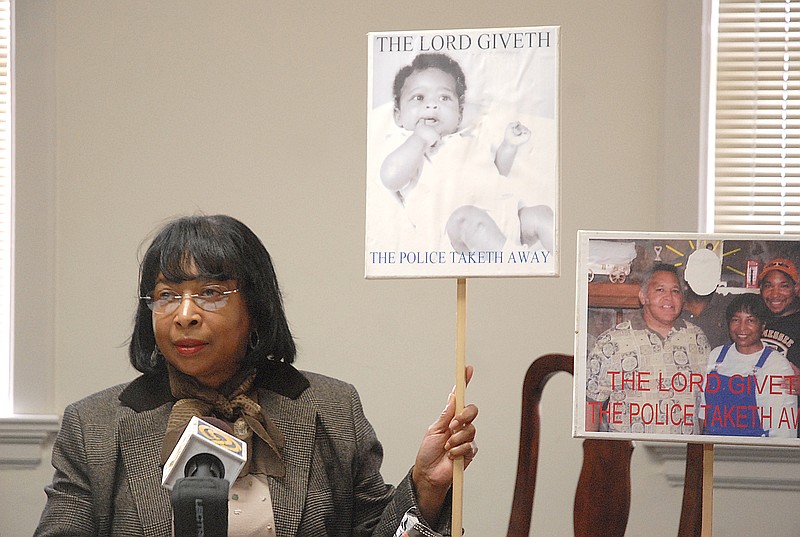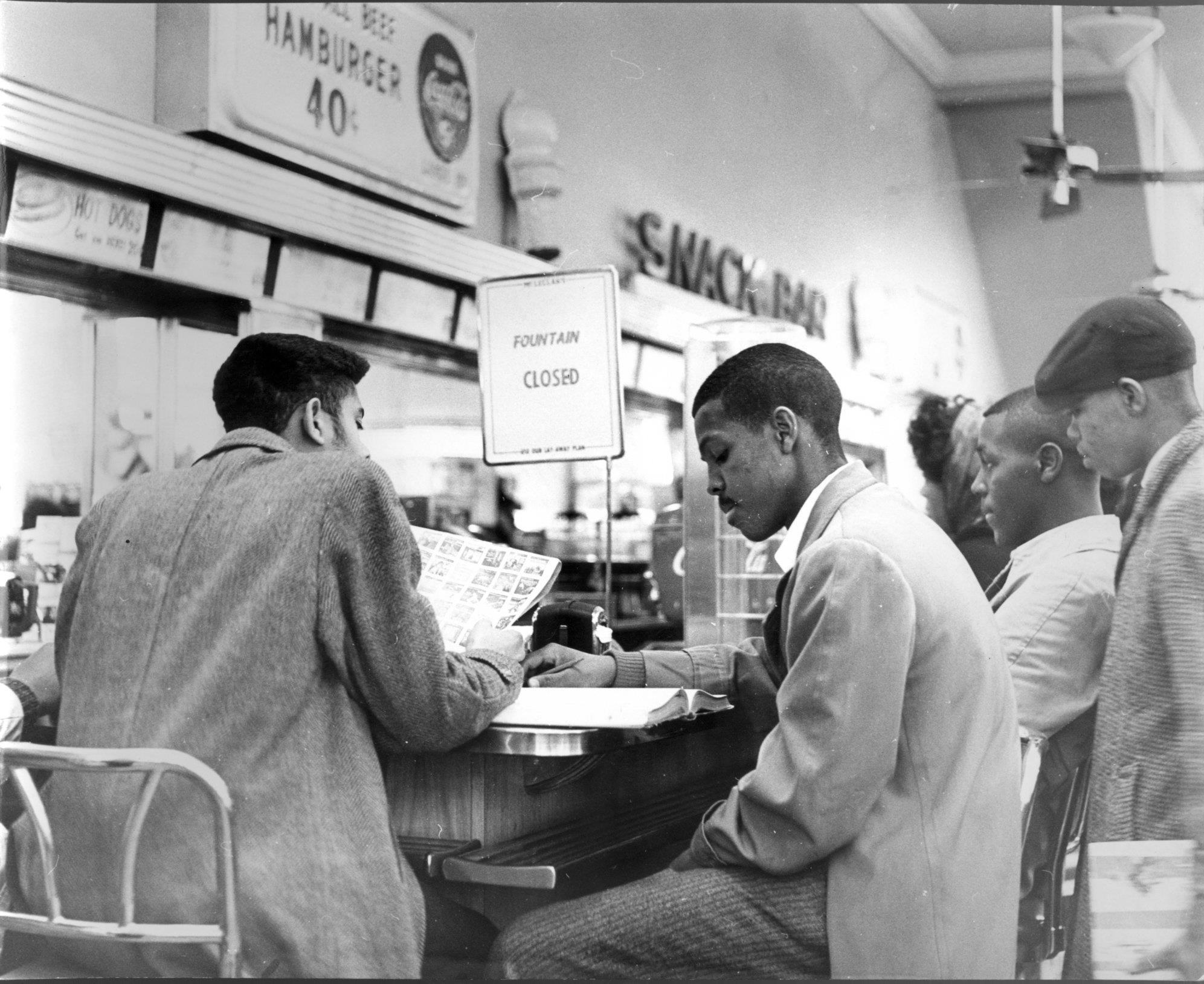This isn't the first time that Chattanooga has seen civil unrest.
Today as protesters march downtown and through parks, they pass over the Walnut Street Bridge, where Ed Johnson, a black man, was lynched 114 years ago. Today's demonstrations echo a long history of protesting the treatment of black people in the area and country.
Activists and concerned citizens march after a string of police brutality cases, most recently the case of George Floyd - a black man who died in police custody after spending nearly nine minutes with his neck pinned under the knee of a white officer in Minneapolis, pleading that he couldn't breathe.
Sixty years ago during the civil rights era, people demonstrated for the same foundational rights of fair and equal treatment for black Americans.
Looking back
In 1960, black Howard High School students lined "whites-only" lunch counters to fight for integration.
"200 Negro Students Sit Down at 4 Stores," the headlines from the Chattanooga Free Press read on Feb. 23, 1960.
Joanne Favors and her classmates know what it's like to make the history and change many are now marching for in 2020. She was a senior at Howard when she decided to join her classmates to take a stand for what they believed in, despite the likelihood of violent opposition.
According to the newspaper coverage of the multiple days of sit-ins, the teenagers faced jeers and food thrown from white onlookers. During these protests, Chattanooga became the first city in six years to use fire hoses on demonstrators.
"We felt that we were being mistreated by not being able to [eat at certain businesses,]" Favors said. "[Protesting] helped me to know that change could occur. I've lived 77 years, almost 78 years, and have seen significant changes. Some didn't last and some did, but I've seen significant changes."
After the death of Martin Luther King Jr., Chattanooga headlines seemed as if they were ripped from the pages of today's papers. Protests were launched, curfews were set, and six days after King's death, the Civil Rights Act of 1968 was passed.
Even since the '60s, Chattanooga has had its share of outcry when it comes to police violence and misconduct, including the recent allegations and lawsuits against Hamilton County Sheriff's Office Deputy Daniel Wilkey, claiming he mishandled traffic stops and a 2004 case with multiple similarities to that of Floyd.
In January of that year, Leslie Vaughn Prater, a Chattanooga black man, died in police custody of "positional asphyxia during physical restraint" after sustaining multiple injuries during his arrest, which the coroner ruled as a homicide.
The four officers involved took temporary leaves of absence and were reinstated after a week, according to a report in the Chattanooga Times Free Press on March 27, 2004.
The incident didn't generate protests like those seen today, but it did result in community backlash and a $1.5 million settlement with the man's family.
Looking forward
When Favors looks at the movements of today compared to her own experiences and those of her peers, she marvels at the diversity of current protests and the way people are able to communicate effectively to the masses.
"I'm just really amazed at their persistence," she said. "They're not just going one time and going home and forgetting about it. They're very persistent in what they're doing."
Local pastor Charlotte Williams, who looks back at how integral faith communities were to the movements in the '60s, hopes today's demonstrations will be a part of history as she and other protesters advocate against decades of police brutality and inequity that have continued, even 400 years after the start of American slavery.
"This has been ongoing," Williams said. "What we've seen with Breonna Taylor and George Floyd and Ahmaud Arbery, those sorts of things were everyday occurrences, so it's not new for us. For 400 years, America has had its knee on the black community. For 400 years, we have been shouting, 'I can't breathe.'"
While stemming from the pain of continued injustice, the demonstrations give Williams hope for true change.
"You see all across [the world] people are saying enough is enough," she said. "You're seeing people come on one accord, you're seeing inter-generational [collaborations] and it's a beautiful thing. It is a beautiful day. And I'm just so happy that I've been able to live to be a part of it."
The current protests appear to be effecting change, even in Chattanooga as new "duty to intervene" policies arise and officials begin talks of evaluating the role that police play in local communities.
But as ripples of change happen, Favors hopes that history won't ever forget the protests of yesterday and of today.
"People tend to forget," she said. "And I want people to remember the young people [and] what they are doing now, to remember the effect that this has had by having been abused by the police.
"Social injustice is still there," she said, "and it's going to take a long time to completely erase it, so [not forgetting] should be a part of our lives."
Contact Tierra Hayes at tierrathejournalist@gmail.com.
PROTEST TIMELINE
—February 1960: Sit-InsBlack students from Howard High School conducted sit-ins at various “white-only” businesses. After days of protests, the city met the demonstrators with fire hoses.—April 1968: Assasination of MLKFollowing the assassination of Martin Luther King, Jr., protests and looting rise in Chattanooga and curfews are established by the city.—Late 1960s-Early 1970s: IntegrationUnrest arose at the attempted integration of Brainerd High School.—1969:Vietnam WarVietnam War protests arrive in the city of Chattanooga—May 1971: Missing musical actsAfter only one of four rock bands shows up at a concert and refunds were refused, approximately 3,000 teens rampaged through the city, an act described by the New York Times as a night of “rioting, burning and looting.” Similar protests had broken out in January of the same year.—June 1979: KKK RallyAccording to an article in the Chattanooga Free Press, 500 people gathered at a house 20 miles north of Chattanooga for a KKK Rally and a cross burning.—July 1980: KKK members acquittedProtests arose after men with ties to the KKK were acquitted of shooting five black women in April 1980.—Late 1980s-early 1990s: AbortionDebates on abortion saw protesters demonstrating at the Chattanooga Women’s Clinic, which led to many arrests. Eventually, an anti-abortion group ended up purchasing the clinic.—February 2003: Possible US-Iraq WarOn Feb. 16, 2003 nearly 300 people marched from Miller Park to Coolidge Park in protest of a possible US-Iraq war.—March 2003: US attack of IraqProtesters joined nationwide demonstrations and gathered downtown in opposition to the US attack on Iraq, signaling the beginning of the Second Gulf War.—2003-2008: US-IRAQ WarArchives show various annual protests are held in continued opposition to the US-Iraq war for at least these five years.—March 2009: UTC Budget CutsMore than two dozen employees and students from the University of Tennessee Chattanooga with signs to protest potential budget cuts that were expected to lead to future layoffs.—April 2009: Tax ProtestsAround 2,000 Chattanooga-area conservatives joined nationwide Tea Party demonstrations in protest of tax rates and increased government spending.—July 2011: TVA power plantProtesters dressed as zombies in 2011 to oppose the Tennessee Valley Authority in reviving an old power plant. TVA soon bans all costumes from its meetings, but is later met with a lawsuit citing First Amendment violations.—October 2011: Occupy ChattanoogaIn 2011, Occupy Chattanooga began, following larger national Occupy Wall Street demonstrations in opposition to large corporations and socio-economic disparities, among other things.—May 2013: GMOsOn May 25, around 200 protestors joined a national movement to ban GMOs in a “March Against Monsanto.”—July 2013:George Zimmerman’s acquittalDowntown Chattanooga sees protests after George Zimmerman is acquitted of muder charges in the death of Travon Martin.—October 2014:Michael Brown, Jr.In 2014, Chattanooga demonstrators with Concerned Citizens for Justice appear to have protested police brutality after the muder of Michael Brown, Jr by a white police officer.—July 2016: Police shootings and violenceProtesters gathered to protest after the police shootings of Alton Sterling and Philandro Castile and the sniper shootings of five Dallas police officers.—November 2016: Dakota Access Oil PipelineHundreds of people march against the Dakota Access oil pipeline due to its potential to threaten Native American populations and a water source.—January 2017:Donald Trump’s InaugurationProtesters gathered in downtown Chattanooga after Donald Trump is inaugurated as president.—January 2017: Women’s MarchFollowing the inauguration of President Donald Trump, demonstrations worldwide, and in Chattanooga, were held in support of women’s rights. The Chattanooga March drew around 3,000 people.—February 2017: Travel BanA protest formed in Chattanooga after Donald Trump enacted a travel ban on seven Muslim-majority countries.—February 2017: Congressional AccessAbout 100 people showed up to protest their lack of access to their congressional leaders.—May-June 2017: LGBTQ RightsIn May of 2017, Chattanoogas held a local LGBTQ Equality March downtown followed in June by protests at Ross’s Landing against Tennessee’s new “natural and ordinary meaning” law.—March 2018: School gun violenceThousands of young people and adults gathered downtown joining nationwide “March for Our Lives” protests against school gun violence. The movement called for better gun control after a Valentine’s Day shooting at a high school in Parkland, Florida, that killed 17 students.—November 2018: Protect Robert MullerA group of people gathered in Chattanooga to protest Donald Trump’s firing of Jeff Sessions and to advocate for the protection and independence of Robert Muller.—May 2020: Reopen ChattanoogaProtesters gathered in opposition to shelter-in-place guidelines meant to slow the spread of the novel coronavirus.—May-June 2020: George Floyd and Black Lives MatterAfter a string of police killings across the country, including the death of George Floyd, Chattanooga joined weeks of worldwide protests.*Information gathered from Chattanooga Free Press, Chattanooga Times Free Press and New York Times archives.

